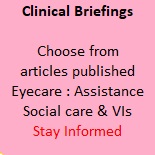General News
AI-supported test can predict eye disease that leads to blindness
AI-supported test can predict eye disease that leads to blindness
In a study reported by Imperial College
 A new eye test can be used to predict a condition that can lead to blindness, according to a new study.
A new eye test can be used to predict a condition that can lead to blindness, according to a new study.
In a clinical trial of 113 patients led by researchers at Imperial College London and UCL, retinal imaging technology called Detection of Apoptosis in Retinal Cells (DARC) was able to identify areas of the eye that were showing signs of geographic atrophy (GA) – a common condition that causes reduced vision and blindness.
The researchers believe that this technology could be used as a screening test for GA and help advance the development of new treatments for the disease. At present, a lack of detectable early symptoms and predictors of disease means that it is difficult to identify GA early enough to avoid any vision loss, and GA is often diagnosed at a late stage.
Age- related macular degeneration (AMD) is the commonest cause of blindness in over-55s and GA is an advanced form of AMD. GA affects 700,000 people in the UK and the incidence is expected to double in the next 25 years. GA develops over several years and can result in progressive and irreversible loss of sight. Although there is no cure, early detection is very important because there are potential treatments that could prevent severe vision loss, or slow the disease’s progression, such as eye injections and tablets.
The new study found that DARC was able to predict new areas of GA growth three years in advance.
The study is published in Progress in Retinal Eye Research.

























